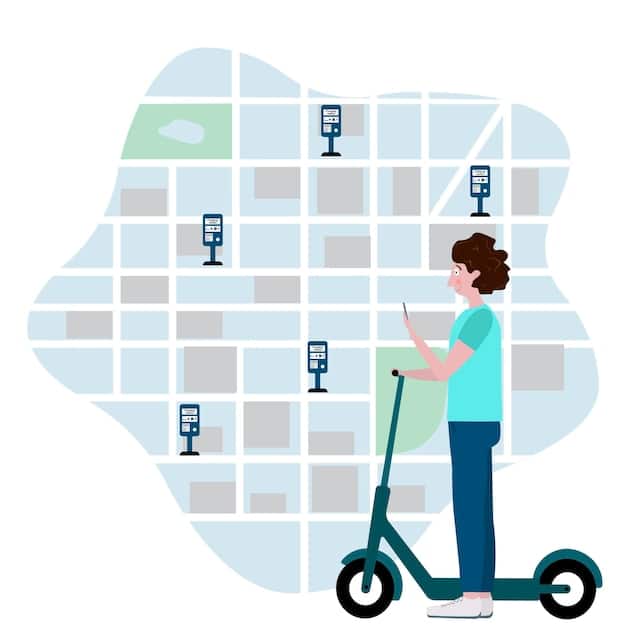Micromobility in the US: E-Scooters and E-Bikes Transforming Transportation

The Rise of Micromobility: Integrating E-Scooters and E-Bikes into US Transportation Ecosystems is reshaping urban transit by offering convenient, eco-friendly alternatives for short-distance travel, impacting city planning and individual commuting habits across the United States.
The Rise of Micromobility: Integrating E-Scooters and E-Bikes into US Transportation Ecosystems is no longer a futuristic concept—it’s a rapidly evolving reality. Across the United States, cities are witnessing a significant shift in how people commute, explore, and navigate their daily lives, thanks to the growing popularity of e-scooters and e-bikes.
Introduction to Micromobility in the US
Micromobility, encompassing lightweight, electric-powered vehicles such as e-scooters and e-bikes, is revolutionizing urban transportation in the United States. These nimble modes of transport offer a compelling alternative to traditional cars for short-distance travel, addressing pressing issues like traffic congestion, air pollution, and the need for more sustainable commuting options.
As cities grapple with the challenges of growing populations and strained infrastructure, micromobility solutions are emerging as a vital component of a more integrated and efficient transportation ecosystem. From bustling metropolises to smaller urban centers, the presence of e-scooters and e-bikes is becoming increasingly common, transforming the way Americans move within their communities.

The integration of micromobility into the US transportation landscape is not without its complexities. Issues such as safety regulations, infrastructure development, and equitable access need careful consideration. However, the potential benefits—reduced carbon emissions, improved urban mobility, and enhanced quality of life—make it a strategic priority for cities across the nation.
The following sections will delve into the current state of micromobility in the US, exploring its key drivers, challenges, and the innovative solutions being implemented to create a more sustainable and accessible transportation future.
The Rise of E-Scooters: Convenience and Challenges
E-scooters have rapidly gained popularity as a convenient and affordable mode of transportation for short trips in urban areas. Their ease of use and accessibility make them an attractive option for commuters, tourists, and anyone looking to avoid traffic congestion.
However, the rapid proliferation of e-scooters has also raised concerns about safety, regulation, and their impact on public spaces. Cities are grappling with the challenge of balancing the benefits of e-scooters with the need to ensure the safety of riders, pedestrians, and other road users.
Safety Concerns and Regulations
One of the primary concerns surrounding e-scooters is safety. Riders often lack proper training and protective gear, leading to accidents and injuries. Additionally, the presence of e-scooters on sidewalks and in pedestrian areas can create hazards for those on foot.
In response to these concerns, many cities have implemented regulations to govern the use of e-scooters. These regulations may include:
- Speed limits in designated zones
- Mandatory helmet use
- Restrictions on riding on sidewalks
- Designated parking areas
The Impact on Urban Infrastructure
The widespread adoption of e-scooters has also highlighted the need for improved urban infrastructure. Many cities lack designated bike lanes and parking facilities for e-scooters, leading to congestion and haphazard parking practices.
Investing in infrastructure that supports micromobility is essential for creating a safer and more sustainable transportation ecosystem. This may include:
- Building dedicated bike lanes
- Creating designated e-scooter parking areas
- Improving street lighting and signage
Many cities are innovating with public transportation by integrating e-scooters and bikes into the public transportation infrastructure. This allows riders to use scooters and e-bikes to complete the first and last mile of thier public transport journeys. Ensuring riders can safely travel to and from public transport locations quickly.
The rise of e-scooters represents both an opportunity and a challenge for urban areas. By addressing safety concerns and investing in appropriate infrastructure, cities can harness the potential of e-scooters to improve urban mobility and promote sustainable transportation.
E-Bikes: Bridging the Gap
E-bikes offer a compelling alternative to traditional bicycles and cars, providing riders with an electric assist that makes cycling easier and more accessible. They are particularly well-suited for longer commutes and hilly terrain, bridging the gap between short-distance micromobility and conventional vehicles.
The popularity of e-bikes is growing rapidly, driven by their versatility, environmental benefits, and ability to promote physical activity. As technology advances and prices become more competitive, e-bikes are poised to play an even greater role in the future of transportation.
Health and Environmental Benefits
E-bikes offer a unique combination of health and environmental benefits. They provide riders with the opportunity to engage in physical activity while reducing their reliance on cars, which can lead to lower carbon emissions and improved air quality.
Studies have shown that e-bike riders get a similar amount of exercise as those who ride traditional bicycles, but they are more likely to cycle more frequently and for longer distances. This can result in significant improvements in cardiovascular health, weight management, and overall well-being.
Types of E-Bikes and Their Uses
E-bikes come in a variety of styles and configurations, each tailored to specific uses and preferences. Some of the most popular types of e-bikes include:
- Commuter e-bikes: Designed for urban commuting, these bikes typically feature comfortable seats, upright riding positions, and integrated racks for carrying cargo.
- Mountain e-bikes: Built for off-road riding, these bikes have robust frames, suspension systems, and powerful motors to tackle challenging terrain.
- Cargo e-bikes: Designed for carrying heavy loads, these bikes feature extended frames, strong motors, and large cargo areas, making them ideal for families and businesses.
They also allow the elderly and people with disabilities the opportunity to have a more accessible form of transport than most. While also being a cost effective alternative to public transport and ride sharing.
E-bikes are proving to be a valuable asset for commuters, recreational riders, and businesses alike. Their versatility and benefits make them a key component of a sustainable transportation future.
Integrating Micromobility with Public Transportation
One of the most promising strategies for maximizing the impact of micromobility is to integrate it with existing public transportation systems. By providing seamless connections between e-scooters, e-bikes, and traditional modes of transport, cities can create a more efficient and accessible transportation network.
This integration can take many forms, including:
- Designated parking areas for e-scooters and e-bikes at transit stations
- Discounted fares for riders who use micromobility to access public transportation
- Real-time information about the availability of e-scooters and e-bikes on transit apps
First-Mile/Last-Mile Solutions
Micromobility can play a crucial role in solving the “first-mile/last-mile” problem, which refers to the challenge of getting people from their homes or workplaces to the nearest transit station.
E-scooters and e-bikes provide a convenient and affordable way to cover these short distances, making public transportation more accessible and appealing to a wider range of people.
In many cities, transit agencies are partnering with micromobility companies to offer integrated services. For example, some agencies allow riders to use their transit cards to unlock e-scooters or e-bikes, while others offer discounts for riders who transfer between transit and micromobility.
By addressing the first-mile/last-mile problem, micromobility can help increase ridership on public transportation, reduce traffic congestion, and promote sustainable commuting habits. This also promotes cost-effective transport throughout areas, reducing the expenses previously associated with owning traditional vehicles.
The Role of Technology and Data
Technology plays a vital role in the success of micromobility, enabling efficient operations, data-driven decision-making, and enhanced user experiences. From mobile apps to GPS tracking, technology is at the heart of the micromobility revolution.
Data is also essential for understanding how people use micromobility services and for identifying opportunities to improve safety, accessibility, and efficiency. By collecting and analyzing data on ridership patterns, trip distances, and accident rates, cities and micromobility companies can make informed decisions about infrastructure investments, regulations, and service offerings.

Mobile Apps and User Experience
Mobile apps are the primary interface for micromobility services, allowing users to locate, unlock, and pay for e-scooters and e-bikes. These apps typically offer features such as:
- Real-time maps of vehicle locations
- Battery level indicators
- Pricing information
- Trip tracking and payment options
In addition to these basic features, many apps also offer safety tips, tutorials, and integration with other transportation services.
Also technology is improving through the Internet of Things (IoT), allowing the vehicles themself ot be smarter. This allows for better vehicle tracking and fleet management which ensures safer use of the e-scooters and e-bikes.
Data Privacy and Security
As micromobility services collect vast amounts of data on users’ movements and behaviors, it is crucial to address concerns about data privacy and security.
Cities and micromobility companies must implement robust data protection measures to ensure that users’ personal information is kept safe and secure. This may include:
- Anonymizing data to protect users’ identities
- Implementing encryption to protect data in transit and at rest
- Providing users with clear and transparent information about how their data is being used
By prioritizing data privacy and security, the technology and micromobility providers can build trust with users and foster the widespread adoption of micromobility services. Also ensuring that it is used safely.
Policy and Regulatory Frameworks
The successful integration of micromobility into US transportation ecosystems requires a clear and consistent policy and regulatory framework. Cities and states must develop regulations that balance the need for innovation with the need to ensure safety and protect public spaces.
This regulatory framework should address issues such as:
- Vehicle safety standards
- Rider licensing and training
- Insurance requirements
- Parking regulations
- Data sharing agreements
Collaboration between Cities and Companies
Effective regulation requires close collaboration between cities and micromobility companies. By working together, cities and companies can develop regulations that are both practical and effective.
This collaboration can take many forms, including:
- Pilot programs to test different regulatory approaches
- Data sharing agreements to provide cities with insights into ridership patterns and safety issues
- Regular meetings and consultations to discuss emerging issues and potential solutions
An effective policy and regulatory framework is essential for creating a thriving and sustainable micromobility ecosystem. Ensuring that all the aspects are appropriately thought through and actioned.
Future Trends and Innovations
The future of micromobility is likely to be shaped by several key trends and innovations, including:
- Advances in battery technology that extend the range and reduce the charging time of e-scooters and e-bikes
- The development of more sophisticated safety features, such as anti-lock brakes and automatic emergency braking systems
- The integration of micromobility with autonomous vehicles and other advanced transportation technologies
As micromobility continues to evolve, it has the potential to transform urban transportation in profound ways. By embracing innovation and investing in sustainable infrastructure, cities can create a more livable, accessible, and environmentally friendly future.
The Rise of Subscription Services
Subscription services are emerging as a popular alternative to traditional micromobility rentals. These services allow users to pay a monthly fee for unlimited access to e-scooters or e-bikes.
Subscription services offer several advantages, including:
- Predictable pricing
- Convenient access
- Reduced reliance on personal vehicles
The widespread adoption of subscription services could further accelerate the growth of micromobility and encourage more people to embrace sustainable transportation options. Also allowing micromobility to play a bigger role in urban areas.
| Key Point | Brief Description |
|---|---|
| 🛴 E-Scooter Popularity | E-scooters offer convenient, short-distance travel, addressing congestion and sustainability. |
| 🚲 E-Bike Versatility | E-bikes bridge the gap with electric assist, suitable for longer commutes and varied terrain. |
| 🚆 Integration with Transit | Micromobility complements public transport, solving first/last-mile challenges. |
| 📱 Tech & Data Driven | Technology enhances operations, drives decisions, and improves user experiences. |
Frequently Asked Questions
What are the main benefits of micromobility?
▼
Micromobility offers several benefits, including reduced traffic congestion, lower carbon emissions, affordable transportation options, and improved accessibility to public transit. How can cities promote the safe use of e-scooters?
▼
Cities can promote safe e-scooter use through regulations such as speed limits, mandatory helmet usage, designated parking areas, and public awareness campaigns about safe riding practices. What role does technology play in micromobility?
▼
Technology enhances micromobility through mobile apps for rentals, GPS tracking for fleet management, and data analytics to improve safety and operational efficiency. How do e-bikes contribute to sustainable transportation?
▼
E-bikes contribute by offering an energy efficient alternative to cars that allows riders to engage in physical activity, reduce carbon emissions, and tackle longer commutes. What are subscription services in the context of micromobility?
▼
Subscription services provide users with unlimited access to e-scooters or e-bikes for a monthly fee, offering predictable pricing and convenient access to sustainable transportation.
Conclusion
Micromobility is poised to reshape urban transportation in the US, offering practical solutions to pressing challenges such as traffic congestion, pollution, and accessibility. By embracing innovation, prioritizing safety, and fostering collaboration between cities and companies, the US can harness the full potential of micromobility to create a more sustainable, efficient, and equitable transportation future for all.
Transportation TechnologyTransportation TechnologyRead more content





